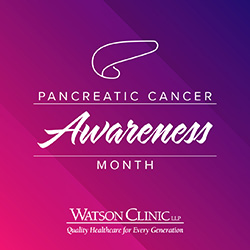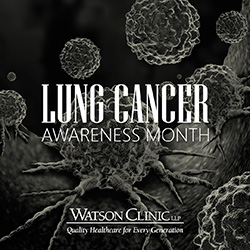
The pancreas is a gland located between the stomach and spine. Its main function is to produce digestive juices that can break down food, and to make hormones that help us control our blood sugar levels.
Most pancreatic cancers are not diagnosed at an early stage. Symptoms are hard to spot at its onset and can easily be confused with those associated with other disorders and diseases. As a result, the cancer has often spread before treatment can be rendered. For this reason, it is one of the deadliest of cancers with a single-digit five-year survival rate.
What are the risks factors that may result in pancreatic cancer? Age is a central factor. Around 2/3 of those diagnosed are 65 years of age or older. The disease is more common in African American communities, and males tend to be diagnosed more than females. Cigarette smoking doubles the risk. Patients who suffer from chronic pancreatitis, obesity, diabetes and maintain a diet rich in fried food, meats and high cholesterol content are also at risk. Hereditary factors may also play a role.
Common symptoms include a loss of appetite, unexplained weight loss, discomfort in the abdomen and back, light-colored stools and dark urine, jaundice and extreme fatigue.
As the pancreas is deeply embedded within the body, diagnosis can be difficult. Doctors may call upon physical examinations, blood tests, biopsy and a variety of imaging technologies – including MRI, ultrasound, PET, and CT scans – to do so. Depending upon the staging of the pancreatic cancer, they might be able to remove the tumor through surgery.
Researchers continue in their efforts to uncover more efficient means of detecting and treating the disease.
If you experience any of the symptoms related to pancreatic cancer, or have questions regarding the disease, The Watson Clinic Foundation urges you to please consult your doctor.
The Watson Clinic Cancer & Research Center specializes in the diagnosis and treatment of cancer in all its forms, including pancreatic cancer. For more information and to schedule an appointment, call 863-680-7780 or visit our location page.
The sooner lung cancer is diagnosed, the better the chances for survival. Until recently, however, early detection has been

difficult—which may be one reason why lung cancer remains the No. 1 cancer killer of both men and women in the U.S.
But there is good news about the disease: Doctors now have a screening test that can catch lung cancer early. It's called low-dose computed tomography (LDCT).
LDCT produces cross-sectional images of the entire chest, including the lungs, using special x-ray equipment and sophisticated computers. These images enable doctors to detect very small nodules in the lung.
Anyone at high risk for lung cancer should get annual LDCT lung cancer screening.
You are at high risk if all three of these things are true for you:
1. You have a pack-year smoking history of 30 years or more. The number of packs of cigarettes you smoked per day multiplied by the number of years you smoked equals your pack years. For example: 1.5 packs a day multiplied by 20 years equals 30 pack years.
2. You smoke now, or you quit within the last 15 years.
3. You're between 55 and 80 years old.
The biggest benefit of LDCT is that it can find lung cancer in its beginning stages, which helps lower the risk of dying from the disease.
Early diagnosis also means that doctors can often use minimally invasive surgery to remove the cancer and preserve more lung tissue.
Other benefits of LDCT include:
• It's fast, painless and noninvasive.
• It uses much less radiation than a traditional CT scan of the chest.
There are possible risks, for instance:
• There may be false positives, perhaps leading to additional tests or more invasive ones.
• Sometimes false negatives occur.
If you think you're at high risk for lung cancer, the Watson Clinic Foundation encourages you to ask your doctor about getting screened with LDCT.
Watson Clinic's Radiology department was recently designated a Lung Cancer Screening center by the American College of Radiology. This distinction reflects the department's commitment to providing low dose screening and diagnostic care for those considered at high risk for cancer. For more information, click here.